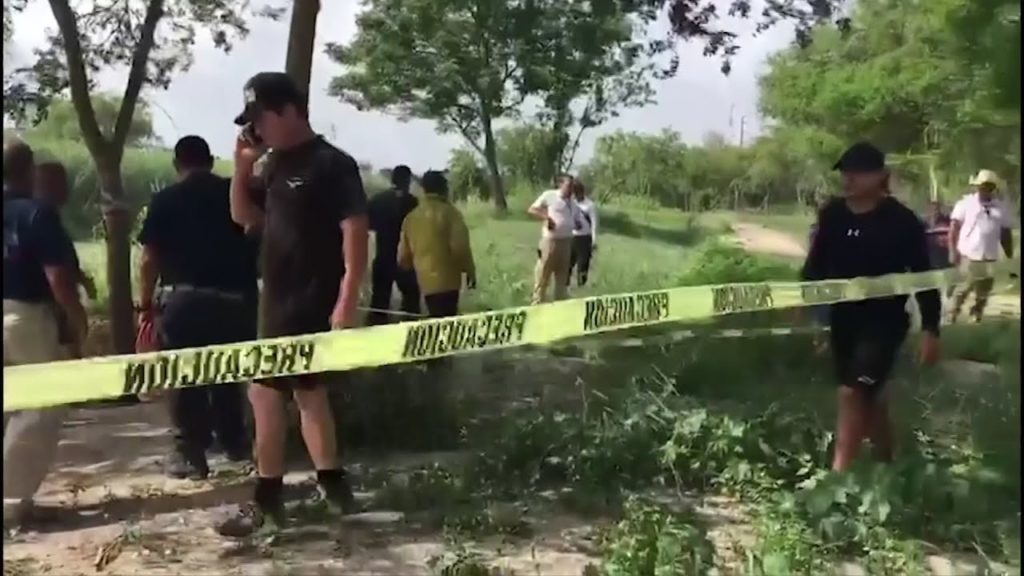The young family from El Salvador appeared in this border city over the weekend with panic on their faces.
They went to the downtown bridge that leads to Brownsville, Texas, where Xiomara Mejia, a migrant from Honduras, explained that the newcomers would not be able to add their names to the long list of families waiting to apply for asylum in the United States until Monday.
“I noticed they were really nervous, scared,” said Mejia, who had arrived in Matamoros with her husband and three children on May 8 and was still waiting to file an asylum application with the U.S. government.
“They said to me, ‘You haven’t tried to cross the river?’” Mejia said. “We said to them, ‘No,’ because of the children more than anything. I don’t know how to swim and my kids do, but either way I’m not going to risk it.”
After chatting, the Salvadoran family said they would come back Monday.
“I didn’t think they were going to decide to cross the river,” Mejia said.
But on Sunday, not far downriver from that bridge, the family crossed a popular bike and jogging path and walked down a slope through the brush to the edge of the Rio Grande.
The river does not appear wide there, maybe 20 to 30 yards, but that short distance obscures the dangers posed by the swift-moving current.
Óscar Alberto Martínez Ramírez, 25, made the crossing first with his 23-month-old daughter, Valeria, then left her on the riverbank while he returned for his wife. But the frightened little girl plunged into the river after him and as he struggled to save her, they both were carried away by the fast-moving waters.
Their bodies were recovered early Monday, lying face down in the mud just a few hundred yards downriver, a heartbreaking scene captured in a news photo — the girl tucked inside her father’s shirt for protection, her arm around his neck.
Martínez’s 21-year-old wife, Tania Vanessa Ávalos, was to accompany the bodies of her husband and daughter back to El Salvador on Thursday.
Tamaulipas state immigration official Enrique Maciel said that Ávalos was “in a total shock” and would not be speaking to reporters. Covered in white sheets, the two bodies were placed into a morgue van to be driven to a funeral home on Wednesday.
“She is afflicted. She is suffering. It is a dream they had to get ahead as a family, the three of them, and she returns in mourning with only the bodies of her family,” Maciel said.
The couple and their daughter had lived with Martinez’s mother in a sea-green brick home with barred windows in a working-class neighborhood of San Martin on the outskirts of the capital, San Salvador.
He worked in a pizzeria and she was a cashier in a fast-food restaurant, his mother, Rosa Ramírez, said.
Ramírez said she had given them the big room in the two-bedroom house, but they dreamed of saving money for a place of their own and decided to head for the United States in early April.
“I told him, ‘Son, don’t go. But if you do go, leave me the girl,’” Ramírez said.
″‘No, mama,’” she said he replied. ”‘How can you think that I would leave her?’”
Now, Ramirez said, she feels a hole that “nobody can fill.”
The region along the U.S.-Mexico border has long been perilous for those trying to cross illegally into the United States between ports of entry, from the fast-moving Rio Grande to the scalding Sonoran Desert. A total of 283 people died while trying to cross last year; figures for 2019 have not yet been released.
News of the weekend drownings, and the shocking photo, resonated in El Salvador among those considering heading north as part of what has been a surge of people from that country, Guatemala and Honduras fleeing poverty and violence.
In a Salvadoran chat group for people thinking about forming a migrant caravan — a phenomenon that drew the ire of U.S. President Donald Trump last year but has all but vanished since Mexican authorities started cracking down — participants discussed the perils of the journey and whether it’s right for parents to take children along.
“If one goes there, they shouldn’t bring children, because going there is risking everything and a child is not prepared for that,” one message said.
“The thing is, it’s more likely that they give you help with children,” someone replied.
“But that’s only if they manage to arrive there,” came the response.
Migration activists worry people may be driven to more risky measures by recent U.S. policies such as “metering” that dramatically reduce the numbers allowed to apply for refuge, as well as others that send asylum-seekers back across the border to wait in Mexico while their cases linger for months or even longer through a backlogged U.S. immigration court system. Wait lists for registering refugee claims with U.S. officials are in the thousands at some ports of entry.
Mexico has also stepped up its immigration enforcement under pressure from Washington.
President Andrés Manuel López Obrador said Thursday that Mexico had a three-month deadline to get the flow of Central American migrants under control and that the country is making progress.
López Obrador did not explicitly say the Sept. 10 deadline had been imposed as part of talks with the U.S. government to avoid tariffs on Mexican exports, but that appears to be the case.
“We think we are going to be able to moderate the migratory phenomenon. We have to,” López Obrador said. “We have a deadline, which is three months, ending Sept. 10, but we are doing well.”
He added that the number of migrants passing through Mexico had doubled in recent times.
Meanwhile, migrant shelters on the Mexico side are overflowing, and in places like Tamaulipas state, where Matamoros is located, cartels and gangs extort, kidnap and murder migrants.
At the downtown bridge Wednesday, Mejia was sure she made the right decision to endure the long wait to make her asylum bid, even though she had seen other families grow desperate with the wait.
She has a daughter with a brain tumor who needs surgery, but they have some relatives in Matamoros who they have been able to stay with, she said.
“We don’t want to cross (through the river), we want to enter through legal channels to the United States and make the case,” Mejia said.
(AP)












2 Responses
What a horrible, but avoidable tragedy. When people make decisions to risk their lives, and the lives of their family, for illegal fantasies, it’s not romanticism, but negligence. Aren’t there jobs in El Salvador, Honduras, Guatemala, and Mexico? It demonstrates to the world that economic opportunity is lacking in so many of these countries, because of the way they are run, who runs them, and that the rest of the world doesn’t enforce some level of competence on governments and regimes that are so obviously corrupt, and lacking for so many. We are apparently the most desirable destination in the world, but our territorial integrity, and immigration requirements are not things illegal immigrants should be dictating to us.
Very sad!